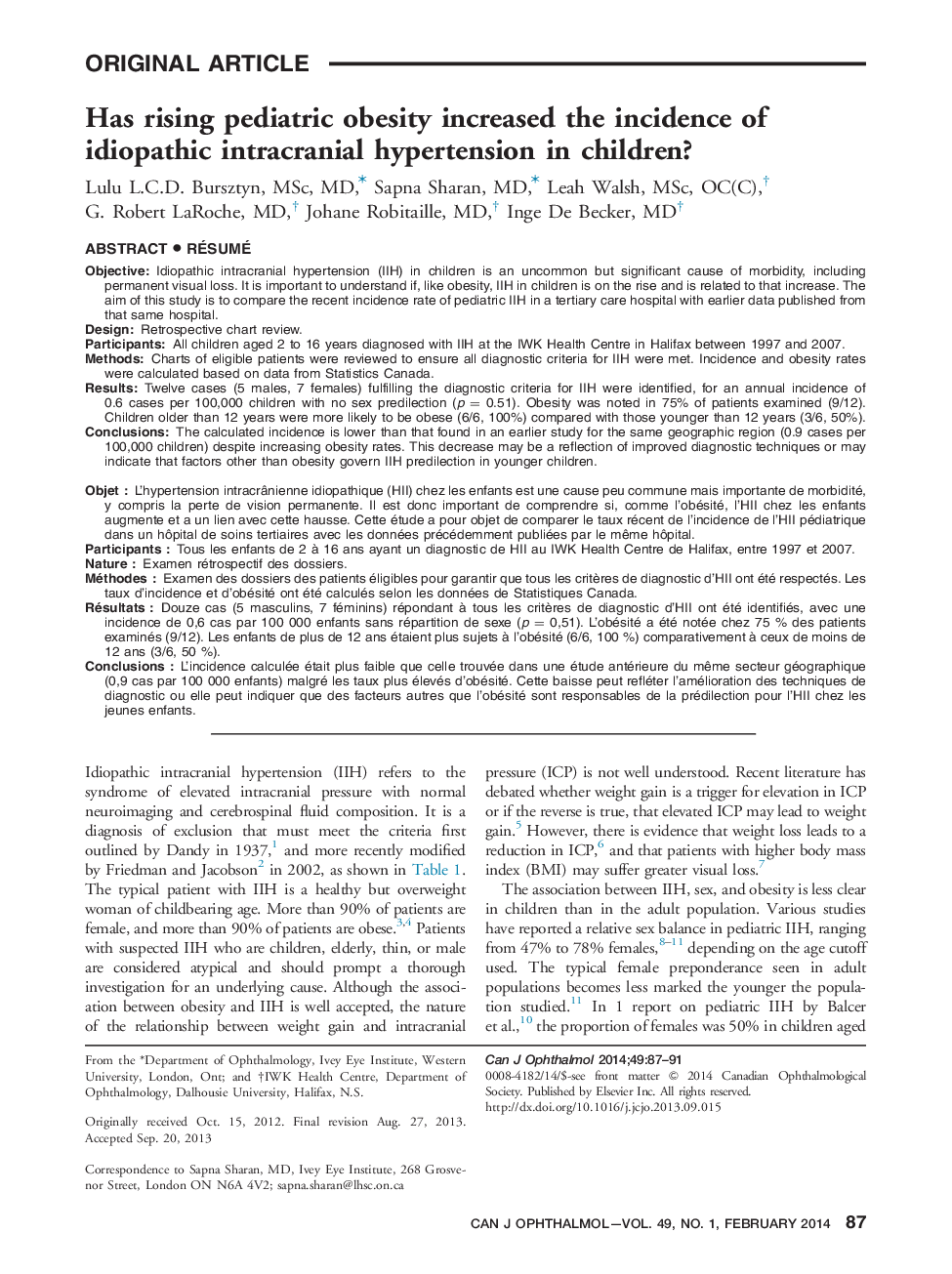| کد مقاله | کد نشریه | سال انتشار | مقاله انگلیسی | نسخه تمام متن |
|---|---|---|---|---|
| 4009153 | 1602405 | 2014 | 5 صفحه PDF | دانلود رایگان |
ObjectiveIdiopathic intracranial hypertension (IIH) in children is an uncommon but significant cause of morbidity, including permanent visual loss. It is important to understand if, like obesity, IIH in children is on the rise and is related to that increase. The aim of this study is to compare the recent incidence rate of pediatric IIH in a tertiary care hospital with earlier data published from that same hospital.DesignRetrospective chart review.ParticipantsAll children aged 2 to 16 years diagnosed with IIH at the IWK Health Centre in Halifax between 1997 and 2007.MethodsCharts of eligible patients were reviewed to ensure all diagnostic criteria for IIH were met. Incidence and obesity rates were calculated based on data from Statistics Canada.ResultsTwelve cases (5 males, 7 females) fulfilling the diagnostic criteria for IIH were identified, for an annual incidence of 0.6 cases per 100,000 children with no sex predilection (p = 0.51). Obesity was noted in 75% of patients examined (9/12). Children older than 12 years were more likely to be obese (6/6, 100%) compared with those younger than 12 years (3/6, 50%).ConclusionsThe calculated incidence is lower than that found in an earlier study for the same geographic region (0.9 cases per 100,000 children) despite increasing obesity rates. This decrease may be a reflection of improved diagnostic techniques or may indicate that factors other than obesity govern IIH predilection in younger children.
RésuméObjetL’hypertension intracrânienne idiopathique (HII) chez les enfants est une cause peu commune mais importante de morbidité, y compris la perte de vision permanente. Il est donc important de comprendre si, comme l’obésité, l’HII chez les enfants augmente et a un lien avec cette hausse. Cette étude a pour objet de comparer le taux récent de l’incidence de l’HII pédiatrique dans un hôpital de soins tertiaires avec les données précédemment publiées par le même hôpital.ParticipantsTous les enfants de 2 à 16 ans ayant un diagnostic de HII au IWK Health Centre de Halifax, entre 1997 et 2007.NatureExamen rétrospectif des dossiers.MéthodesExamen des dossiers des patients éligibles pour garantir que tous les critères de diagnostic d’HII ont été respectés. Les taux d’incidence et d’obésité ont été calculés selon les données de Statistiques Canada.RésultatsDouze cas (5 masculins, 7 féminins) répondant à tous les critères de diagnostic d’HII ont été identifiés, avec une incidence de 0,6 cas par 100 000 enfants sans répartition de sexe (p = 0,51). L’obésité a été notée chez 75 % des patients examinés (9/12). Les enfants de plus de 12 ans étaient plus sujets à l’obésité (6/6, 100 %) comparativement à ceux de moins de 12 ans (3/6, 50 %).ConclusionsL’incidence calculée était plus faible que celle trouvée dans une étude antérieure du même secteur géographique (0,9 cas par 100 000 enfants) malgré les taux plus élevés d’obésité. Cette baisse peut refléter l’amélioration des techniques de diagnostic ou elle peut indiquer que des facteurs autres que l’obésité sont responsables de la prédilection pour l’HII chez les jeunes enfants.
Journal: Canadian Journal of Ophthalmology / Journal Canadien d'Ophtalmologie - Volume 49, Issue 1, February 2014, Pages 87–91
